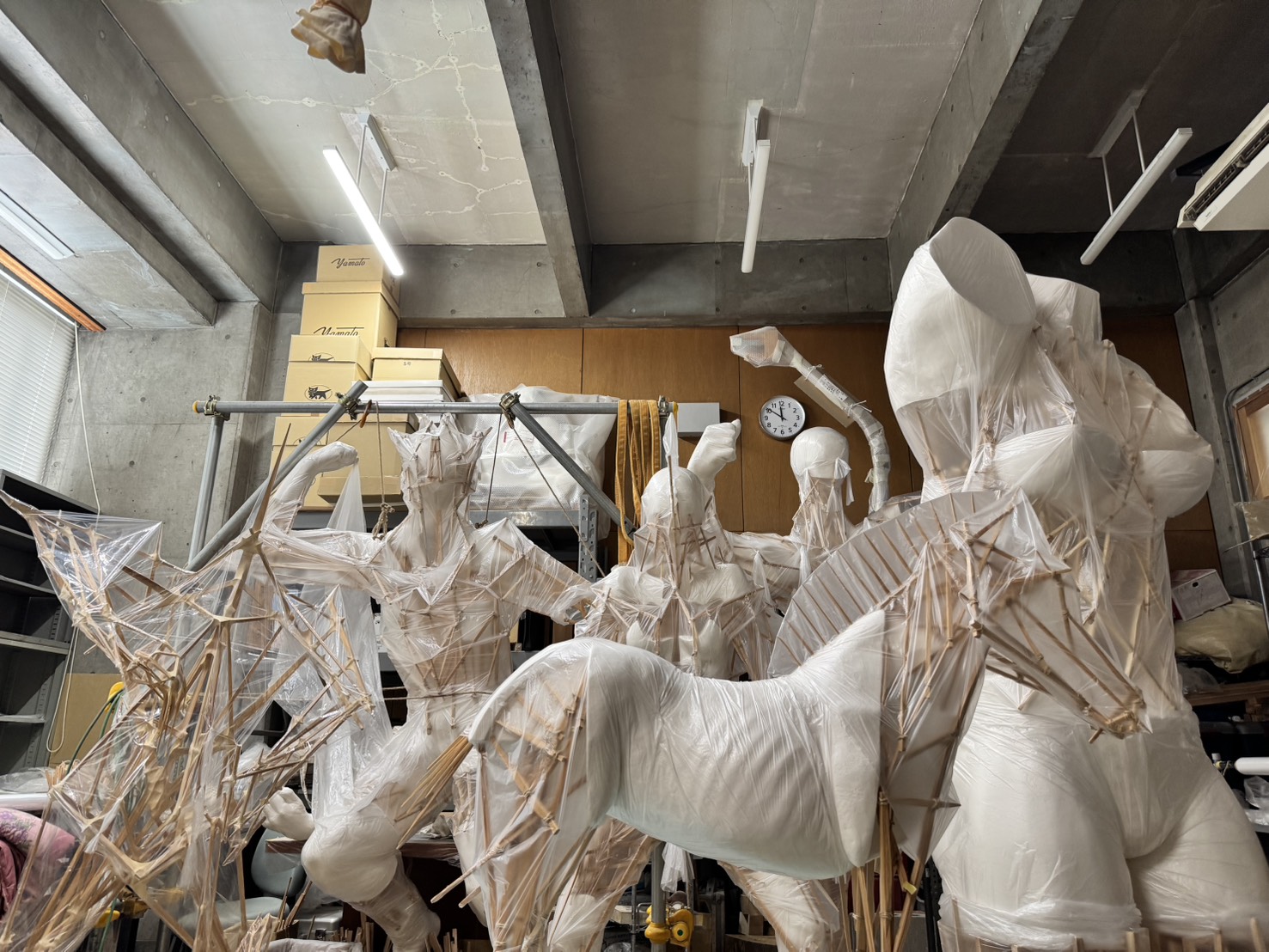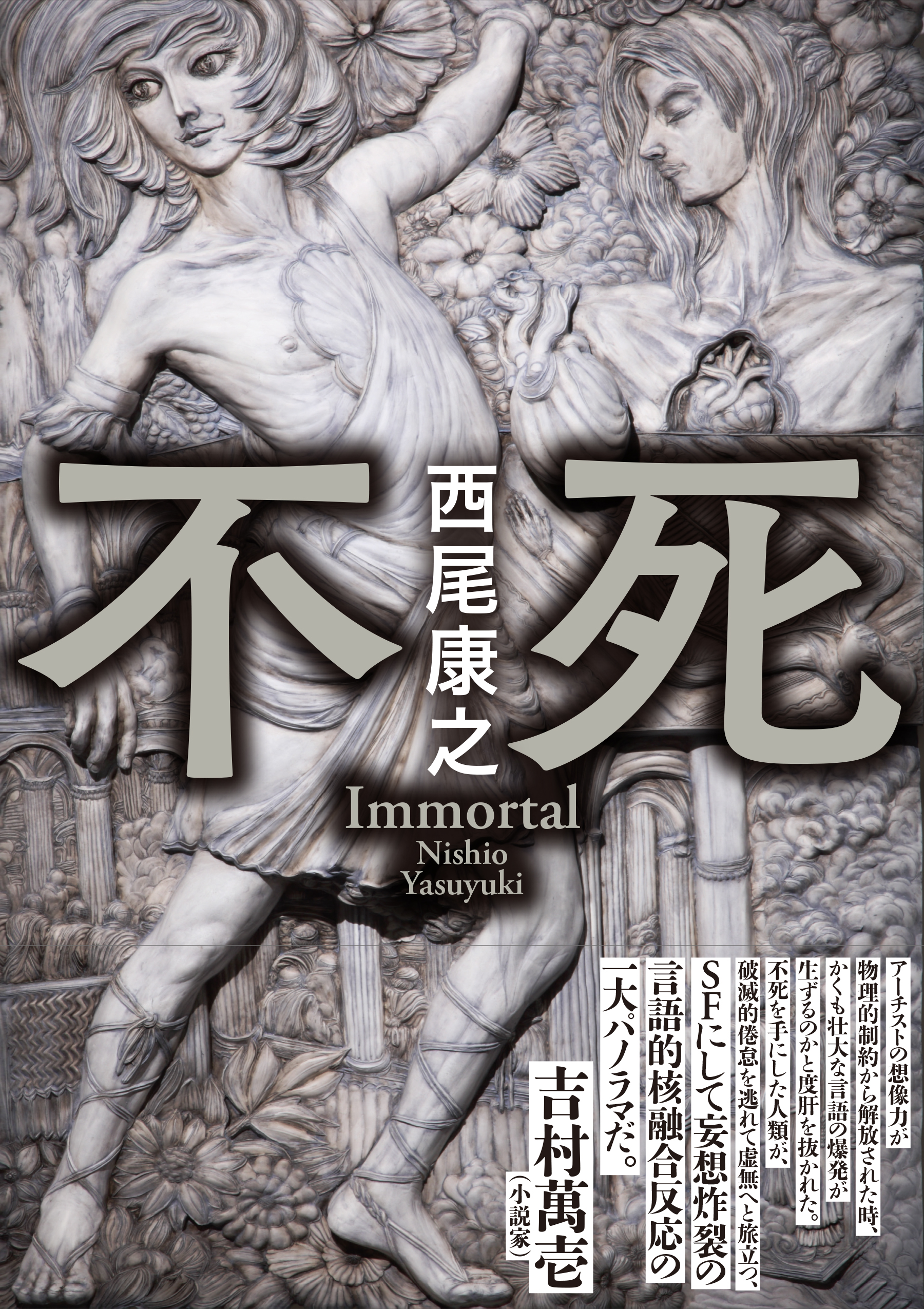
Yasuyuki Nishio
Solo Exhibition
Compactification
2025.11.22(Sat)- 12.20(Sat)
Opening hours: 12:00 – 18:00
Closed on Sundays, Mondays, and holidays
Opening reception: 11.22 (Sat) 17:30 – 19:00
Talk session: 11.22 (Sat) 16:00 – 17:30 *Japanese only
Speakers: Yasuyuki Nishio, Naoya Hirata (Artist)

Studio view
We at ANOMALY are pleased to announce an upcoming solo exhibition of works by Yasuyuki Nishio titled “Compactification”. The exhibition will run from November 22 (Sat.) to December 20 (Sat.). It will be his first solo exhibition in a full nine years, since “R E M (Rapid Eye Movement)“.
“Compactification”, the theme this time, derives from the concept of topology. A compact topological space can be understood as a structure in which solution sets satisfy certain desirable properties. Nishio explains that this can occur in two ways: either S covers X and exists as a balloon-like closed continuum, or the elements of S are all open sets forming an urn-like structure as an open covering. As for material, the artist replaces such abstract concepts with vinyl, a familiar substance and thin membrane that also plays a leading role in approaches to environmental problems, and uses it for concrete plastic expression.

Studio view
Thus far, Nishio has created expressions related to thin membranes. n this context, he explains that the contact between himself and the environment is a border without volume, and that his connection with the world exists through emptiness.
In his works, Nishio incorporates things that can be seen but have no substance, such as “negative casting” and expressions in virtual space. Through this approach, the take on the form of sculptural objects that are as thin as a membrane. While they exude a strong presence, they also convey a sense of void between the artist and the viewer.
The three-dimensional vinyl works in this exhibition are created using a membrane-based structure. Within their translucent interiors, struts are arranged to support the membrane, giving the central form a provisional framework. This approach allows Nishio to overcome the usual dilemma in sculpture, where the internal structure is hidden upon completion, and makes it possible to retain information about the interior at the same time as the work is finished. For Nishio, the confrontation between structure and viewer, mediated through the membrane, marks a moment of acquiring a new expressive topos.

The cover of “Immortal”, Nishio’s novel.
The exhibition also features drawings that were selected as illustrations for “Immortal”*1, Nishio’s recently published full-length novel.

“SPACESHIP – GRAVE MARKER”(2012)©Yasuyuki Nishio
Photo:Keizo Kioku
Yasuyuki Nishio initially became known for his unique sculptural technique called “negative casting.” In addition to three-dimensional works, he has freely explored a wide range of media, including ghost paintings, oil paintings, installations, and even forms created in virtual spaces.
Negative casting involves pressing clay with one’s fingers to create marks that then serve as molds for casting. Rather than producing a traditional “solid figure,” this method generates forms as negative contours or echoes, bringing them into relief through casting. The traces, flows, and passage of time left by the artist’s fingers become an invisible layer that “membranizes” the entire work. Through this process, the physical traces embedded in the creation reveal the presence of the subject.
Notable works include the monumental six-meter-long “Crash Sayla Mass” and the five-meter “Minsk”, both of which overwhelm viewers with their sheer scale and presence. Other representative works include the “Giantis series” , featuring 50-meter-tall women destroying cities in the name of “justice,” reminiscent of Ultraman, as well as contemporary ink ghost paintings inspired by spiritual visions and the fear of ghosts. Many of these works engage with themes of eros and thanatos, reflecting Nishio’s ongoing exploration of desire, mortality, and the human condition.
Intense inner impulses always run through Nishio’s works. In many cases, they are rooted in his fear of death and loss, and his attachment to living. Depending on his experiences and times, he converts traumas born of fantasies into creations and gives form to anxiety about his own existence through his sensational themes. This charges his works with a raw energy that directly affects the senses of the viewer. Sculptures and paintings are topoi for the intersection of inner worlds and bodily sensations, and lead the viewer to previously unknown feelings and vivid experiences.

“R E M (Rapid Eye Movement)” installation view, YAMAMOTO GENDAI, 2016
In his previous solo exhibition “REM (Rapid Eye Movement)”, Nishio showed “sculptures” expressing fear of death and nihility as well as thought on life with three-dimensional computer-generated (CG) animation. These sculptures modeled on human beings did not exist as matter; they were numerical formations made by computer graphics.
The title “REM “refers to the rapid movement of the eyeballs during REM sleep. To the artist, sleep has been understood as a remembrance of death and rebirth, and physiological action symbolizing involvement with nothingness. Nishio turned the gap between existence and the void into a theme. The viewers wore head-mounted displays, had their vision of the real world cut off, and experienced only the virtual world created by Nishio. As a result, they became entities that did not really exist, exactly like ghosts who had lost their bodies. The work presented experiences that instantly alternated between life and death, and existence and void.
Nishio said he once thought, “To me, who continued to produce sculpted works as the upshot of existential anxiety, CG technology was of prime importance as a tool for coming into contact with the gap between existence and emptiness.” Nevertheless, he is developing actual existences through membranes permeated with nothingness in real space again.
Born in 1967 in Tokyo, Nishio graduated from the Department of Sculpture at Musashino Art University, College of Art and Design, in 1991. Since then, he has participated in exhibitions such as “Transform “(Yamamoto Gendai, 2004), “Super Healthy Child” (NADiff Gallery, 2008), and “Exoticism” (Yamamoto Gendai, 2012). While employing a unique sculptural technique focused on human figures and imagery, he continues to develop a diverse and expansive artistic practice.
For Compactification, this exhibition, Nishio is making concrete topological concepts by means of membrane structures and vinyl materials. The exhibition presents new techniques and ideas distinct to the artist.
*1 “Immortal”, Yasuyuki Nishio, Kuma Publishing, 2025.
Born in 1967 in Tokyo.
Nishio graduated from the Department of Sculpture at Musashino Art University. Since 2020, he has been an Associate Professor at Tokyo University of the Arts.
He is known for his unique sculptural technique, “negative casting,” in which works are created from molds made solely from the impressions of fingers pressed into clay. Notable works include the five-meter-long battleship “Minsk “(2004) and the six-meter-tall “Crash Sayla Mass” (2005), whose immense scale and labor-intensive production give them a striking presence. In addition to sculpture, he also produces ink paintings and oil paintings.
In his 2016 solo exhibition at Yamamoto Gendai, Nishio presented “REM (Rapid Eye Movement)”, an immersive work in which viewers, wearing head-mounted displays, could visually experience crowds of figures created in 3D computer graphics.